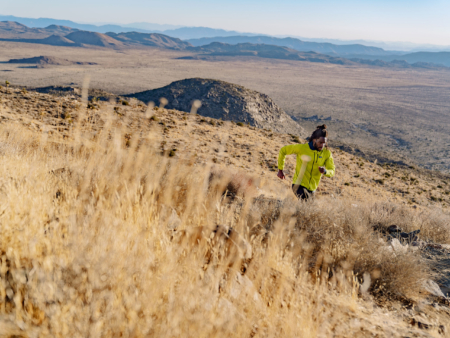Home Is an Open Place
How the trails beneath our feet help us belong.
Listen to the story
All photos by michael a. estrada
The lead-in to my off-road run naturally flows from the rudimentary through to the complex; the cadence of my strike aligns with nature and shouts in unison. It’s as if Mother Earth’s perfect marrying of sculpted feet and ancient land generates a higher sense of awareness. I am not interrupting. I am just a part of it all, as was intended.
My longing to be in harmony with the trails beneath my feet never ceases to submerge me into an array of emotions. It is a jumble of unclear feelings, yet open terrain continues to lure me back. I find myself bewildered that trail running, a space that first felt so hostile, can afford me the greatest sense of freedom—whether it be the unpaved open spaces of the Mojave Desert, Griffith Park’s covert nature or the sun-kissed Verdugo Mountains, all but one situated within arm’s reach of my humble Los Angeles, California, home.
I would never have discovered the solace of these unpaved paths if it weren’t for my mother. She fostered a sense of belonging in me, a feeling that I deserve to exist in spaces that had a pretense of being separate. In the Black community, there’s a tendency to tell people we don’t belong in certain spaces because they are “for white folks.” In saying this, it’s almost like saying Black people shouldn’t exist, period. My mother never uttered those words.
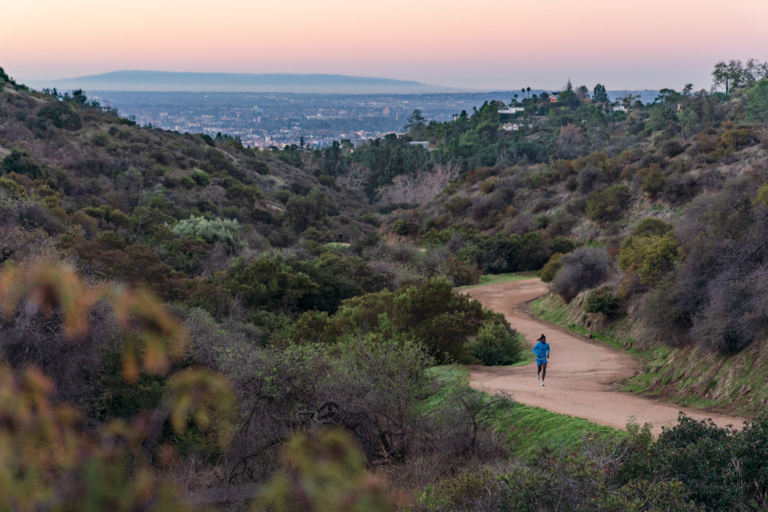
City and trail, two parts of a whole. Griffith Park, California.
Mothers have the unique ability to recognize a wilting child, and while the reasons may not be obvious, sometimes the solutions are. She uprooted me from South Central Los Angeles and replanted me 100 miles east to Apple Valley, located at the Mojave Desert’s southern edge. She made it possible for me to exist. The unpredictability of Inglewood’s environment created a need for me to heighten my senses. I became, and remain, acutely aware of my surroundings. What started as an act of survival became a tool I utilized while living in the desert—always two steps ahead to forestall the possibility of danger, perceived or real. I soon realized the ability to see everything provides a level of understanding much more suited to nature. It’s an evolutionary process instrumental to the dominance of the human species, tailoring fear into survival. As we rely less on our survival instincts, those who are not forced to become aware may instead become complacent.

Midmorning, full sprint.
I’m careful when speaking of my early childhood neighborhood of Inglewood. No need to disparage where I come from; society already paints an awful picture of what goes on south of the 10. My argument is that it’s not the community’s people who bear responsibility; rather, it’s the impact of the environment in which these people find themselves that perpetuates certain perceptions. The United States has an ugly past of systematic redlining, and Los Angeles is no stranger to this. Once abundant with fertile land, South Central was paved over, industrialized and molded to fit the suburban dream, only to be abandoned by white flight. This idyllic neighborhood, bound by oil fields, freeways and a then-growing airline industry, was home to an increasing population of Black people and lost its economic allure in the eyes of the real estate moguls—its suburban dream “stained” by the existence of Black bodies. Although Black people worked hard to develop healthy communities and invested in each other, the county’s lack of support and interest, poor health and education policies, and failing economic and social infrastructure created an ongoing uphill battle. South Central Los Angeles, and places like it, are nutrient-deficient communities, where access to the great outdoors is scarce. These factors make opportunities to reclaim nature’s spaces few and far between.
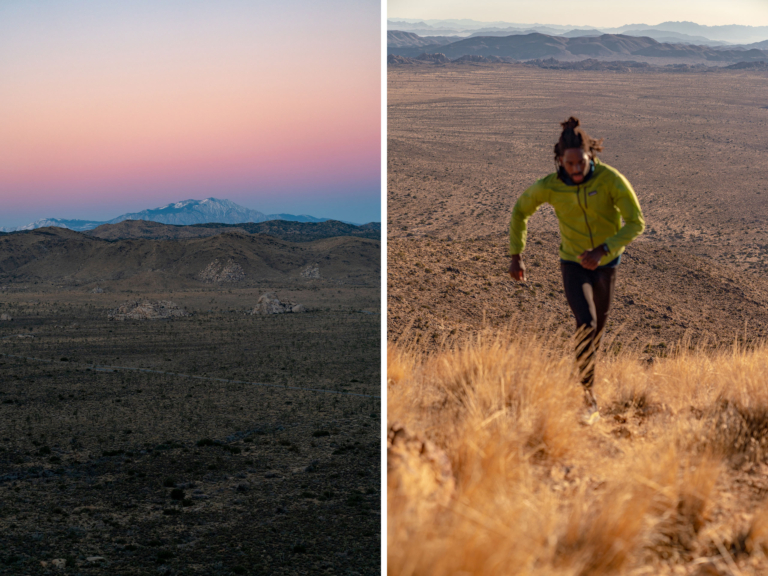
Left: Sunrise over contrast. Right: Upward movement.
The High Desert can gift you with an extraordinary sentience. The tranquil dryland exchanged my heightened awareness of human error and pollution for a newfound clarity and presence of mind. I recall gazing at the stars above in the ink-black night and, at that moment, understanding how insignificant I was while simultaneously feeling a sense of awe at the universe and its great unknown. If this was what the sky above could offer, what more could the earth below reveal? I had ignited a desire for exploration; I reaped respect and confidence to work with what the land had to offer.
Dwelling in wide-open spaces with vast distances to cover and limited access to modern modes of transportation, I learned the value of what I naturally possess: I was born to run.
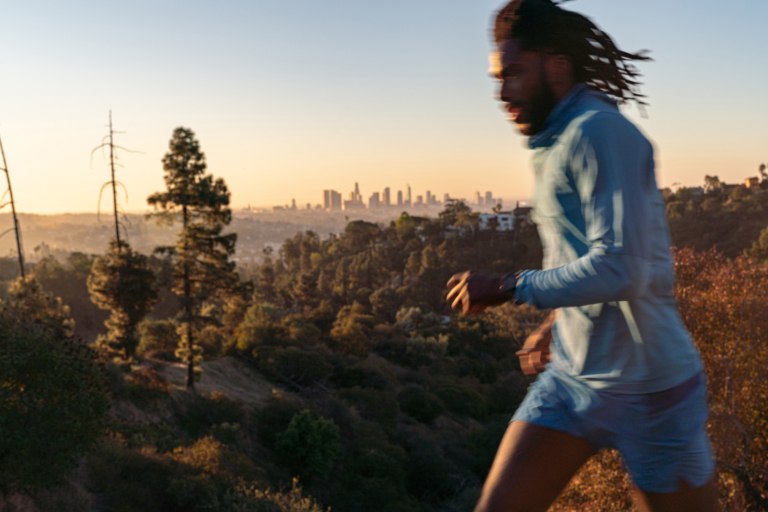
Motion blur.
As much as the earth and my body belonged together, I discovered outside factors that would impact my ability to immerse myself in my new passion completely. Fears that even as an adolescent, I was acutely aware of but less inclined to listen to, as is the rebellious youth’s nature. Much to my dismay, as an adult, those fears became more real the more time I spent in places typically associated with whites. As I entered those spaces, I was exposed to the discomfort that other humans can create with as little as a look or as much as an unsavory comment. At what point does that comment become an action? A crippling thought.
I’m torn between what I love and the possibility of violence. It can be enough to nearly make me forget about the special connection I share with the soil beneath my feet, whiplashing me back to the reality that I am a Black body in a space where representation is stunted. Who on these trails can I recognize and share the unspoken, subtle nod of the head as I run by? Where is the modern-day Negro Runner’s Green Book?
I have run thousands of miles, with only a few bad experiences. Yet, I am disproportionately giving these encounters the power to make me fall victim to stereotype, pushing me off the trails and back onto the streets. This comes from observing systemic ideology or symbolism in a world where Black people are valued for their sporting ability, but only in spaces that have been predetermined to be for them. Even then, society has repeatedly proven that those spaces are not safe. That knowledge is psychologically detrimental to my well-being, and the challenge is to overcome my fears and society’s misconceptions.
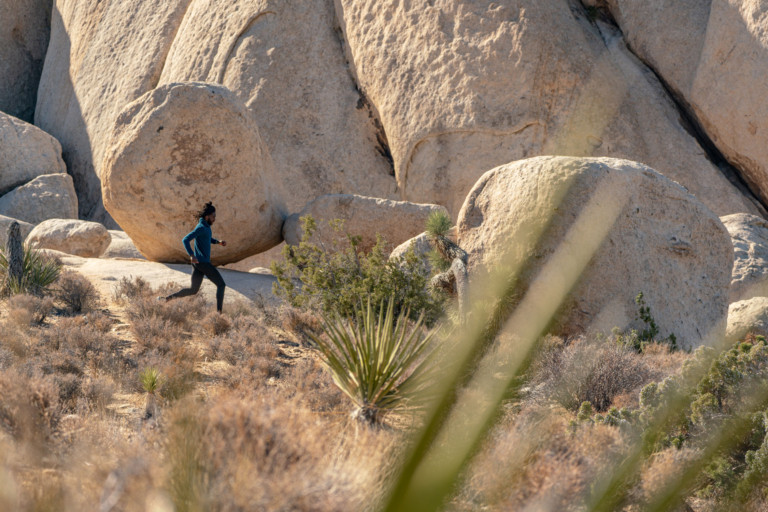
The solace of unpaved paths.
I have chosen to disregard the media’s historic portrayal of who belongs in outdoor spaces—a narrative that undeniably omitted the presence of the Black body. I will pursue these spaces, spirited, with my head held high and my feet grounded, every step rewriting the narrative. Showing up on the trail marks a footprint for others like me to follow, spawning a shoaling effect, ultimately easing our collective foreboding.
Mother Nature is the keeper, and we are her temporary inhabitants. It was not her intention for humans to dictate whom she belongs to, but rather we who should understand that we belong to and are part of her. Our human-made perceptions of space and belonging, ownership and property have little to do with the freedom from our humanness that running in nature can provide. We can learn so much about our ability as humans to survive despite adversity by observing nature, the intricacies of balance, the cycles, the elements interweaving and the coexistence of all her inhabitants.

Griffith Park with the Observatory in the distance. The Gabrielino/Tongva Nation, Fort Mojave Indian Tribe, Southern Paiute, and San Manuel Band of Mission Indians have lived in what is now called Southern California for millennia. Their unceded lands form the parks where many of us enjoy running today, and where the photos for this story were taken.
Many moons and miles through maturation have led to a better understanding of my first home in Inglewood, where I presently stand. I’ve learned that despite her dysfunctions, this mother gave me the courage to sit with my discomfort and channel the energy to conquer mountains and valleys: to know that I belong here. At the crest is the vantage point where it has become clear that folks like me exist in these spaces. I just had to climb higher to catch the view.
This story was first published in the Patagonia Fall 2021 Journal.
